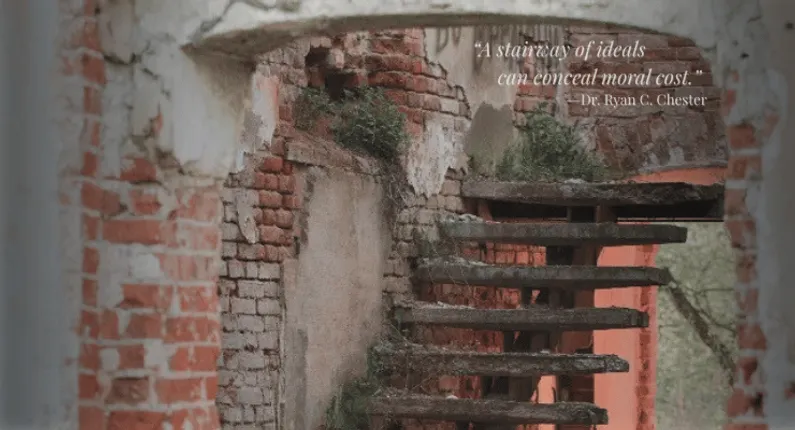
Residential Recovery and the Problematic Ideal of Recruitment from Within
Residential recovery centers often struggle with a built-in idealistic recruitment model that may engender a moral conflict for its clients, which could, in turn, lead to moral trauma and recidivism; that is, a return to the addictive lifestyle and an abandonment of the individual’s gains toward personal sustainability in recovery. The above likely stems from a mistaken view of business and management that falls into what I term, the PICS trap:
- P – PURPOSE: A misplaced understanding of the purpose of business and management.
- I – IMAGE: A top-down push to equate programmatic success with long-term client-to-employee retention and sustainability through synchronized messaging to prospective clients and the broader marketplace.
- C – CONFLATION: A business mindset that conflates the culture of recovery with operational best practices.
- S – SCARCITY: A subversive philosophical and ethical belief in financial and revenue scarcity.
The following example is illustrative:
Purpose
A residential addiction recovery center believes that the purpose of the center is singularly focused on helping people overcome addiction and other behavioral health dependencies. Management is therefore conditioned to narrowly focus on getting clients in the door and ensuring staff are enabled and competent to help them on their 30-to-90-day journey toward victory over substances.
Image
To demonstrably prove that the center is not only capable but programmatically superior to other recovery solutions (including comprehensive, full-spectrum, integrated, or holistic treatment, recovery, and/or transitional housing centers), upper management encourages recruiting new staff from recent alumni or clients in their last weeks at the clinic.
Management then pushes the message into the marketplace that many of their alumni end up becoming employees, often supplying alumni-to-non-alumni staffing ratios as further evidence of their success. The strategic objective behind this tactic is to broadcast an image that clients are so transformed by their victory at this particular facility that they want to remain and help others achieve the same triumph they experienced at this facility.
The messaging suggests that the program is not only successful but is also such a culturally vibrant and healthy organization that clients end up becoming dedicated employees and evangelists for the program.
Conflation
However, the culture of recovery becomes unintentionally suffused with the business of recovery. Bringing clients through recovery does not necessarily correlate to a cognitively healthy alumnus—someone emotionally equipped to handle reentry into life’s numerous encumbering dynamics—or someone capable of mentoring others toward sustainable resilience.
Furthermore, business best practices require screening employee candidates based on factors such as stability, competency, qualifications, and ability to collaborate with other staff. These practices must consider the overall adherence to the business culture as distinct from the recovery culture that ideally suits clients.
Best practices empirically know or intuitively realize that Alcohol and Other Drug (AOD)-related problems are prone to chronic relapse (Kelly et al., 2019). Substance Use Disorders (SUD), a broader category of analysis, similarly suffer from chronic relapse (Beaulieu et al., 2021).
In fact, relapse in SUD ranges between 40–60% after the first year and 50% after five years (Beaulieu et al., 2021). SUD recovery must, therefore, be regarded as a long-term endeavor, with the total time to complete recovery and abstinence from substance usage averaging 17 years (Beaulieu et al., 2021).
The market has observed these trends, and some centers are adopting the long-term view of residential treatment (18 months or more), with results demonstrating a 23.9% increase in SUD abstinence (Beaulieu et al., 2021).
The net result of the data is that the long-term view of recovery is far superior to the short-term view. Thus, the treatment center that recruits from within employs individuals likely to succumb to recidivism. Since the recovery culture does not beget a business culture, the business culture is forced to conflate recovery culture with business culture.
Scarcity
A primary reason for recruiting from within is management’s belief in the scarcity of financial resources. Whether cash flow is generated from government grants, private donations, client revenues, or any combination therein, leadership often commits to a pattern of behavioral confirmation bias.
Financial insecurity seeps into management’s philosophical outlook. The threat of financial shortfalls also comes from the ever-looming possibility of changes to state licensure requirements and adjustments to insurance policies.
In response, management resists recruiting from external sources, as the cost of this process is much higher than hiring from within. Leadership justifies the savings by reasoning that recent alumni:
- Have the heart to help others.
- Understand the client culture.
- Have demonstrated remarkable success in short-term recovery.
- Are hard workers with a proven record of trust and dependability.
- Are respected by other clients.
Alumni are hired at a low hourly rate under the ethical frame that the organization is giving them opportunity.
The problem is that alumni are often not emotionally or cognitively resilient enough to live sustainably under the compounded pressures of social and familial reintegration. The likelihood of moral conflict and recidivism is high.
The solution is to not fall into the PICS trap, because doing so likely positions alumni to resort to their cognitive and substance-based dependencies. A sound and thorough evaluation of the business mission, culture, purpose, and philosophy is warranted—particularly as it pertains to hiring from within.
Under the pretense of helping others, the business of recovery has the potential of becoming pretentious.
Citations
- Kelly, John F., Martha Claire Greene, Brandon G. Bergman, William L. White, and Bettina B. Hoeppner. “How Many Recovery Attempts Does it Take to Successfully Resolve an Alcohol or Drug Problem? Estimates and Correlates From a National Study of Recovering U.S. Adults.” Alcoholism: Clinical and Experimental Research 43.7 (Jul 2019): 1319–1599. https://doi.org/10.1111/acer.14067.
- Beaulieu, Myriam, Joël Tremblay, Claire Baudry, Jessica Pearson, and Karine Bertrand. “A systematic review and meta-analysis of the efficacy of the long-term treatment and support of substance use disorders.” Soc Sci Med 285 (September 2021). https://doi.org/10.1016/j.socscimed.2021.114289.





